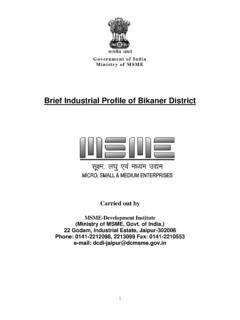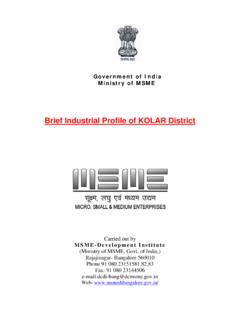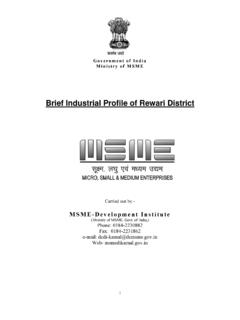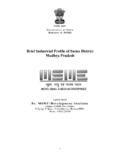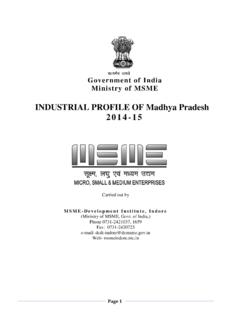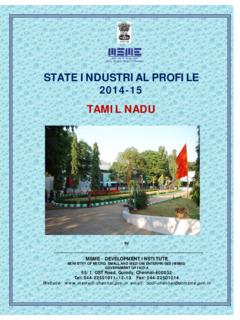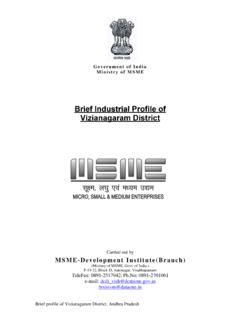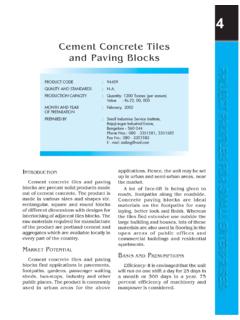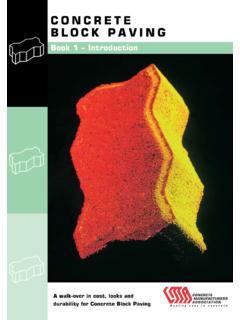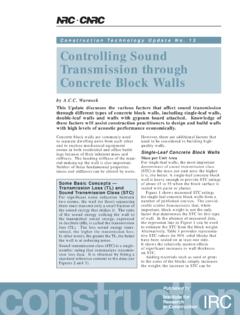Transcription of PROJECT PROFILE ON CEMENT CONCRETE HOLLOW …
1 1 PROJECT PROFILE ON CEMENT CONCRETE HOLLOW BLOCKS PRODUCT : CEMENT CONCRETE HOLLOW Blocks NIC CODE : 26959 (based on NIC 2004) PRODUCT CODE : 94459 (based on ASICC 2000) PRODUCTION CAPACITY : Quantity : 600000 Nos. per annum Value : Rs 72 Lakhs per annum QUALITY STANDARD : IS 2185 (Part 1): 2005 (Third Revision) MONTH & YEAR : January 2011 of Preparation PREPARED BY : Glass & Ceramics Division MSME Development Institute Govt of India, Ministry of MSME 65/1, Road, Guindy, Chennai - 600 032 Phone: 044-22501011 2 INTRODUCTION OF THE PRODUCT CEMENT CONCRETE HOLLOW blocks have an important place in modern building industry. They are cost effective and better alternative to burnt clay bricks by virtue of their good durability, fire resistance, partial resistance to sound, thermal insulation, small dead load and high speed of construction.
2 CONCRETE HOLLOW blocks being usually larger in size than the normal clay building bricks and less mortar is required, faster of construction is achieved. Also building construction with CEMENT CONCRETE HOLLOW blocks provides facility for concealing electrical conduit, water and sewer pipes wherever so desired and requires less plastering. MARKET & DEMAND ASPECTS CEMENT CONCRETE HOLLOW blocks are modern construction materials and as such are used in all the constructions viz. residential, commercial and industrial building constructions. Construction industry is a growing a sector. The demand for this product is always high in all cities and other urban centres due to construction of residential apartments, commercial buildings and industrial buildings. Growing public awareness of the advantages of the product coupled with increase in the government and financial institutions support for housing which is a basic human necessity would ensure a healthy growth in the demand.
3 IMPLEMENTATION SCHEDULE Sl Description of the activity Time (approx.) 1 Selection of the product 1 month 2 Preparation of the PROJECT report 3 Selection of the location 4 Registration of enterprise with DIC 5 Mobilising finance for the PROJECT 4 months 4 Purchase of land 5 Construction of building 6 Procurement of machinery and equipment 7 Obtaining EB connection 8 Erection and commissioning of machinery and equipment 9 Recruitment of manpower 1 month 10 Trial run and commencement of production Total PROJECT implementation period 6 months 3 PRESUMPTIONS (1) Interest rate: 15% per annum on total capital investment is taken into consideration (2) Margin money: The promoter may bring in one-third of both fixed capital and working capital requirements. (3) Efficiency: 75% utilisation of machinery and manpower has been considered. (4) Labour wages: Minimum wages applicable for semi-skilled and unskilled workers were taken into consideration.
4 (5) Working shifts per day: It is envisaged that the enterprise will be in operation on single shift of 8 hours per day basis for 300 working days in year. (6) Implementation period: PROJECT implementation period of 6 months is envisaged RAW MATERIALS CONCRETE is a mixture of ordinary Portland CEMENT , mineral aggregate (sand and stone chips) and water. The water used in preparing the CONCRETE serves two purposes: (1) It combines with the CEMENT to form a hardened paste (2) It lubricates the aggregates to form a plastic and workable mass The water that combines with the CEMENT varies from about 22 to 28% of the total amount of mixing water in CONCRETE . Mineral aggregates (sand and stone chips) are normally divided into two fractions based on their particle size. Aggregate particles passing through the or mm Indian Standard sieve are known as fine aggregate.
5 The particles retained on this sieve are designated as coarse aggregate. Natural sand is often used as fine aggregate in CEMENT CONCRETE mixture. Coarse aggregate are crushed stone chips. Crushed stone chips broken into particle sizes passing through the mm sieve may also be used as fine aggregate. The maximum size of the coarse aggregate that may be used in CEMENT CONCRETE HOLLOW blocks is mm. However, the particle size of the coarse aggregate should not exceed one third thickness of the thinnest web of the HOLLOW blocks. Ordinary Portland CEMENT is the cementing material used in CEMENT CONCRETE HOLLOW blocks. CEMENT is the highest priced material per unit weight of the CONCRETE . Hence, the fine and coarse aggregates are combined in such proportions that the resulting CONCRETE is workable and has minimum CEMENT content for the desired quality. 4 MANUFACTURING PROCESS The process of manufacture of CEMENT CONCRETE HOLLOW blocks involves the following 5 stages; (1) Proportioning (2) Mixing (3) Compacting (4) Curing (5) Drying (1) Proportioning: The determination of suitable amounts of raw materials needed to produce CONCRETE of desired quality under given conditions of mixing, placing and curing is known as proportioning.
6 As per Indian Standard specifications, the combined aggregate content in the CONCRETE mix used for making HOLLOW blocks should not be more than 6 parts to 1 part by volume of Portland CEMENT . If this ratio is taken in terms of weight basis this may average approximately at 1:7 ( CEMENT : aggregate). However, there have been instances of employing a lean mix of as high as 1:9 by manufacturers where HOLLOW blocks are compacted by power operated vibrating machines. The water CEMENT ratio of by weight basis can be used for CONCRETE HOLLOW blocks. (2) Mixing The objective of thorough mixing of aggregates, CEMENT and water is to ensure that the CEMENT -water paste completely covers the surface of the aggregates. All the raw materials including water are collected in a CONCRETE mixer, which is rotated for about 1 minutes. The prepared mix is discharged from the mixer and consumed within 30 minutes.
7 (3) Compacting The purpose of compacting is to fill all air pockets with CONCRETE as a whole without movement of free water through the CONCRETE . Excessive compaction would result in formation of water pockets or layers with higher water content and poor quality of the product. Semi-automatic vibrating table type machines are widely used for making CEMENT CONCRETE HOLLOW blocks. The machine consists of an automatic vibrating unit, a lever operated up and down metallic mould box and a stripper head contained in a frame work. 5 Wooden pallet is kept on the vibrating platform of the machine. The mould box is lowered on to the pallet. CONCRETE mix is poured into the mould and evenly levelled. The motorised vibrating causes the CONCRETE to settle down the mould by approximately 1 to 1 inches. More of CONCRETE is then raked across the mould level. The stripper head is placed over the mould to bear on the levelled material.
8 Vibration causes the CONCRETE come down to its limit position. Then the mould box is lifted by the lever. The moulded HOLLOW blocks resting on the pallet is removed and a new pallet is placed and the process repeated. The machine can accommodate interchangeable mould for producing blocks of different sizes of HOLLOW or solid blocks. (4) Curing HOLLOW blocks removed from the mould are protected until they are sufficiently hardened to permit handling without damage. This may take about 24 hours in a shelter away from sun and winds. The HOLLOW blocks thus hardened are cured in a curing yard to permit complete moisturisation for atleast 21 days. When the HOLLOW blocks are cured by immersing them in a water tank, water should be changed atleast every four days. The greatest strength benefits occur during the first three days and valuable effects are secured up to 10 or 14 days.
9 The longer the curing time permitted the better the product. (5) Drying CONCRETE shrinks slightly with loss of moisture. It is therefore essential that after curing is over, the blocks should be allowed to dry out gradually in shade so that the initial drying shrinkage of the blocks is completed before they are used in the construction work. HOLLOW blocks are stacked with their cavities horizontal to facilitate thorough passage of air. Generally a period of 7 to 15 days of drying will bring the blocks to the desired degree of dryness to complete their initial shrinkage. After this the blocks are ready for use in construction work. QUALITY SPECIFICATIONS IS 2185 (Part 1): 2005 Indian Standard: CONCRETE Masonry Units Specification (Part 1) HOLLOW and Solid CONCRETE Blocks (Third Revision) 6 The above standard specifies requirements for these parameters: dimensions, grades of HOLLOW blocks, blocks density, compressive strength, water absorption, drying shrinkage, and moisture movement PRODUCTION CAPACITY The plant and machinery proposed in the PROJECT has a production capacity of 800000 Nos.
10 Of CEMENT CONCRETE HOLLOW blocks of size 100X200X400 mm. At 75% utilisation of the capacity, productions of 600000 Nos. of blocks have been taken into consideration. CEMENT CONCRETE HOLLOW blocks are usually of the following three dimensions: 100X200X400 mm, 150X200X400 mm and 200X200X400 mm. Although HOLLOW blocks of all the three sizes could be made using the same machinery and equipment proposed in the PROJECT , for computation purpose only one size viz 100X200X400 mm is considered in the sales turnover. HOLLOW blocks of other sizes could also be made depending on the user requirement. With the given set of machinery and equipment used in making the HOLLOW blocks, solid blocks could also be made with the help of additional mould sets only. UTILITIES Electrical Power requirement: 25 HP power for industrial purpose is required. Water: water used in making CONCRETE should be free from acids, alkalis, oil, dissolved carbon dioxide and decayed vegetable matter.
